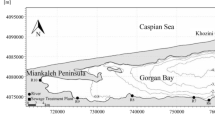Abstract
River plumes are the major source of nutrients, sediments, and other pollutant into the coastal waters. The predictive capability of a 3D hydrodynamic model (POMGL), a version of the common Princeton Ocean Model (POM), adapted for the Great Lakes, is assessed versus field measurements. The model was applied to simulate the nearshore hydrodynamics as the Grand River plume entering Lake Michigan. A nesting technique was adapted to represent the circulation and thermal structure of the surface river plume with a higher resolution. The model was compared with extensive field studies in the vicinity of Grand Haven. The current predictions showed fairly good agreement with observations, although the thermal structure of the flow especially near the river mouth was not very well represented. The model showed a weak stratification and a mild temperature transition from the plume to the lake water and therefore more diffusion. Application of hydrostatic models in exchange flows (e.g., buoyant river plumes) is recommended with reservations and coupling of these models with near field entrainment or empirical models to consider the nonhydrostatic nature of lake-river interface currents.







Similar content being viewed by others
References
Beletsky, D., & Schwab, D. J. (2001). Modeling circulation and thermal structure in Lake Michigan: annual cycle and interannual variability. Journal of Geophysical Research, 106(9), 19,745–19,771.
Beletsky, D., Schwab, D. J., & McCormick, M. J. (2006). Modeling the 1998–2003 summer circulation and thermal structure in Lake Michigan. Journal of Geophysical Research, 111, 1–18.
Blumberg, A. F., and Mellor, G. L. (1987). “A Description of a three-dimensional coastal ocean circulation model.” Three dimensional coastal ocean models, Vol. 4, N. Heaps, ed., American Geophysicists Union, Washington, D.C., 1–16.
Carnelos, S. L. (2003). “Urban Stormwater Runoff Discharges to Lake Pontchartrain: 3-D Hydrodynamic Model for Plume Behavior and Fate and Transport of Pathogens in the Effluent.” Thesis University of New Orleans, 474.
Csanady, G. T., Sullivan, P. J., Berretta, M., Bergs, A., and Hale, A. M. (1964). “Hydrodynamic Studies on Lake Huron at Baie Du Dore.” Report No. PR 19, Water Resources Institute, University of Waterloo and Great Lakes Institute, University of Toronto.
Ezer, T., & Mellor, G. L. (2000). Sensitivity studies with the North Atlantic sigma coordinate Princeton Ocean Model. Dynamics of Atmospheres and Oceans, 2000(32), 185–208.
Fringer, O. B., Gerritsen, M., & Street, R. L. (2006). An unstructured-grid, finite-volume, nonhydrostatic, parallel coastal ocean simulator. Ocean Modelling, 14, 139–173.
Hamidi, S. A., Bravo, H. R., & Klump, J. V. (2013, May). Evidence of multiple physical drivers on the circulation and thermal regime in the green bay of Lake Michigan. In World Environmental and Water Resources Congress 2013@ sShowcasing the Future (pp.1719-1726). ASCE. doi:10.1061/9780784412947.169
Hamidi, S.A., Bravo, H. R., Klump, J.V., Waples, J.T. (2014). “Preliminary Investigations of Water Exchange between Green Bay and Lake Michigan” UW-Milwaukee School of Freshwater Sciences: Green Bay Hypoxia Technical Report 2014-H1.
Hamidi, S.A., Bravo, H. R., Klump, J.V., Waples, J.T. (2015). “The role of circulation and heat fluxes in the formation of stratification leading to hypoxia in Green Bay, Lake Michigan.” Journal of Great Lakes Research, under Press.
HydroQual, Inc. (2005). “ECOMSED: three-dimensional hydrodynamic and sediment transport model.” HydroQual, Inc., Mahwah, N.J. Available online from www.hydroqual.com/ehst_ecomsed.html
Marshall, J., Hill, C., Perelman, L., & Adcroft, A. (1997). Hydrostatic, quasi-hydrostatic, and nonhydrostatic ocean modeling”. Journal of Geophysical Reseach, 102(C3), 5733–5752.
Martin, P. J., (1985). “Simulation of the mixed layer at OWS November and Papa with several models.” Journal of Geophysical. Research., (90), 903–916.
McCorquodale, J. A., Georgiou, I., Carnelos, S., & Englande, A. J. (2004). Modeling coliforms in storm water plumes. Journal of Environmental Engineering and Science, 3, 419–431.
Mellor, G.L., (2004). Users Guide for a three-dimensional, primitive equation, numerical ocean model, Princeton University.
Nekouee, N., Roberts, P. J. W., Schwab, D. J., & McCormick, M. J. (2013). Classification of buoyant river plumes from large aspect ratio channels. Journal of Hydraulic Engineering, 139(3), 296–309.
Pearson, H. J., Puttock, J. S., & Hunt, J. C. R. (1983). A statistical model of fluid element motions and vertical diffusion in a homogeneous stratified flow. Journal of Fluid Mechanics, 129, 219–249.
Peeters, F., (1994). “Horizontale Mischung in Seen (Horizontal mixing in lakes).” Ph.D. thesis, Eidgenossische Technische Hochschule, Zurich.
Rao, Y. R., Skafel, M. G., & Charlton, M. N. (2004). Circulation and turbulent exchange characteristics during the thermal bar in Lake Ontario. Limnology and Oceanography, 49(6), 2190–2200.
Schwab, D. J., & Bedford, K. W. (1994). Initial implementation of the Great Lakes Forecasting System: a real-time system for predicting lake circulation and thermal structure. Water Pollution and Research in Journal of Canada, 29, 203–220.
Stevens, C. L., Lawrence, G. A., & Hamblin, P. F. (2004). Horizontal dispersion in the surface layer of a long narrow lake. Journal of Environmental Engineering and Science, 3(5), 413–417.
Stocker, R., & Imberger, J. (2003). Horizontal transport and dispersion in the surface layer of a medium-sized lake. Limnology and Oceanography, 48(3), 971–982.
Thomson, W. (1871). XLVI. Hydrokinetic solutions and observations. The London, Edinburgh, and Dublin Philosophical Magazine and Journal of Science, 42(281), 362–377.
Tsanis, I. K., & Wu, J. (2000). “Application and verification of a three-dimensional hydrodynamic model to Hamilton Harbour, Canada”. Journal Global Nest: The International, 2(1), 77–89.
Wu, J. (1994). “An Integrated Hydrodynamic and Pollutant Transport Model for the Nearshore Areas of the Great Lakes and Their Tributaries." Ph.D. Thesis, McMaster University, Canada.
Acknowledgments
The authors gratefully acknowledge the financial support from NOAA, Oceans, and Human Health Initiative (OHHI), the assistance of the Great Lakes Environmental Research Laboratory for providing POMGL code, and the observation data.
Author information
Authors and Affiliations
Corresponding author
Rights and permissions
About this article
Cite this article
Nekouee, N., Hamidi, S.A., Roberts, P.J.W. et al. Assessment of a 3D Hydrostatic Model (POM) in the Near Field of a Buoyant River Plume in Lake Michigan. Water Air Soil Pollut 226, 210 (2015). https://doi.org/10.1007/s11270-015-2488-1
Received:
Accepted:
Published:
DOI: https://doi.org/10.1007/s11270-015-2488-1




